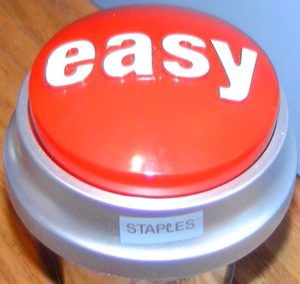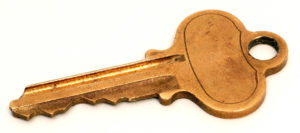Some of the most influential communication techniques are also extraordinarily easy. Here’s a technique that will take your presentations up a notch with almost zero effort.
All you have to do is ask people to “fill in the ________.”
Mediocre presenters are tempted to just tell people what they want them to know. The best presenters let the audience tell themselves. If you want the audience to tell themselves, you can’t say it for them.
How to get people to fill in the ________?
 Step 1: Give them a ________.
Step 1: Give them a ________.
Step 2: Wait!
You can do this in multiple media:
Verbal: Say everything except the ________, then pause.
Written: Write your sentence on a handout, replace one word or phrase with a ________. Expect them to write in the answer.
Visual: Write something on the slide, whiteboard, or flip chart, but leave something out. Wait for them to mentally or verbally fill it in.
Physical: Use a gesture to indicate a ________ in addition to silence, OR use a gesture in place of a word.
How it Works
________s do amazing things! Here are just a few of the principles in my SpeechDeck public speaking system that you implement every time you let the audience “fill in the ________:”
C Clarify Your Content
First of all, when you add ________s, you will become instantly easier to understand with almost no effort. Why? Because deciding what words to omit forces you to identify and clarify your keywords.
If you don’t have a well written headline sentence or takeaway message, it will be hard to blank-ify a meaningful keyword.
If you do have a clear message, you’ll immediately identify the takeaway, and you will easily find a _ _ _word in the sentence that best conveys that point. Replace it with a ________ or ??? or — or *** or whatever.
One of the easiest and most common ways to use the fill-in, is by asking the audience to repeat your main points back to you in a summary at the end of your presentation.
A Inject Anticipation
100% of the time, ________s create anticipation. The uncertainty of not knowing the answer forces people to pay closer attention. Granted, the technique can get old. You might even be _______ of my doing it already.
After years of coaching, I’ve found that the public speaking skill of generating anticipation is the single hardest one of the 8 SpeechDeck principles for most of my clients. “Fill in the _______” is a simple solution that anyone can do with little effort.
R Develop Relationships
 Not only do you get people curious about what belongs in the ________, but the entire audience usually fills it in TOGETHER! Whenever you arrange for simultaneous or cooperative activities, you are creating group conformity.
Not only do you get people curious about what belongs in the ________, but the entire audience usually fills it in TOGETHER! Whenever you arrange for simultaneous or cooperative activities, you are creating group conformity.
Encouraging conformity in others is another very difficult presentation skill for most amateurs. “Fill in the ________” makes it easy.
Because everyone is conforming to the same experience together at the same time, subconsciously they are developing stronger group bonds with each other. Group psychology makes them enjoy the experience more and makes them more impressionable at the same time.
P Encourage Participation
Participation is the most obvious benefit of “fill in the ________.” Every fill-in is either a mental, physical, verbal, written, or social activity! When the audience is participating they will learn faster, enjoy it better, and remember more.
I Empower the Individual

There are two types of ________s:
The first kind of a ________ only has one right answer. When there is only one right answer, you are using the blank to emphasize YOUR keywords.
When I get you to repeat, or fill-in MY keywords, I’m helping you remember what I want you to know, but I’m NOT increasing your ownership of the information in a way that persuades you.
To empower YOU, the listener, I have to give you a _______ that allows you to fill in YOUR OWN words, not MY words. When you use your own words, you will _______________ better.
I have no idea what you put in that last ________. Whatever word or phrase you came up with is what you want to hear. The most persuasive argument I can make is the one you want to hear, and since I don’t know what that is, I let you fill it in for yourself.
T Manage the Theater
Theater means that in a public speaking situation you have to use the space available to you in addition to words. Of course, you don’t have to use a literal ________ to ask for a fill-in.
Use any symbol, silence, gesture, or alternate representation that takes the place of the message you want them to remember. Even better, use more than one.
You probably don’t even have to try. If you create a visual or verbal ________, your body language will most likely produce perfectly appropriate gestures without any conscious effort.
As an added bonus, the ________ gives you, the speaker, a visual cue that helps YOU stay on topic.
S Engage the Subconscious
On a subconscious level the fill-in plays visual and auditory tricks on the listener’s mind. It disrupts expectations with a sensory experience, and forces the subconscious to tune in.
When you use a literal ________, it’s the best type of engagement. It’s not imaginary, it’s not vicarious, it’s not even just visual. An effective ________ produces a tangible, sensory experience.
Not only that, but it forces you, the presenter, to pause. Click here for an article on the magic of pauses.
In the subconscious is where the magic happens. Your “fill in the ________” will create spontaneous conversation, encourage participation, provoke humor, and possibly even draw out emotion.
The end result will be that by touching on those internal feelings and motivations, your presentation will leave more impact.
Your Commitment
Imagine a public speaking technique that takes only seconds to implement and yet does all of that!
When a technique helps you ________ this well, you should definitely ________! Do yourself a favor and complete this sentence: Next time I give a presentation I’m going to try to ________________________________.
Danger Sign image adapted from: https://www.flickr.com/photos/cogdog/6064546472, CC 2.0


